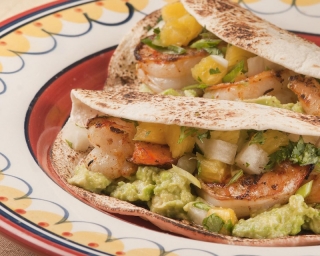
Street Foods Take Off
27 January 2016Around for millennia, street foods are driving consumer discovery of global flavors, ingredients and preparations.
By Wook Kang, CEC, CFBE, MCFE, ACE
Street food was the world’s first fast food. Although the history of street food hearkens to ancient Greece, it’s as on-trend today with consumers as if it were just discovered. And in this country, today’s street food goes way beyond traditional American offerings such as hot dogs and pretzels.
Just like fast food, street foods benefit by customer demand for convenience, portability, affordability and, above all, flavor. They’re often sold from a portable food booth, food cart or food truck and meant for immediate consumption. Some street foods are regional, but many—such as the Philly cheesesteak—have spread beyond their regions of origin.
According to a recent study from the Food and Agriculture Organization, 2.5 billion people around the world eat street food every day. And Americans constitute a growing percentage of that overall customer base.
“From Korean fusion tacos to authentic Greek souvlaki, Americans just can’t get enough of these handheld ethnic meals,” says Gerry Ludwig, CEC, corporate consulting chef for broadline distributor Gordon Food Service. “And, even though these dishes take their cues from traditional street-side vendors, they are equally well received in a restaurant dining room.”
Sandwiches Spur Street Food Seduction
Many street foods in the United States and around the world are sold in the form of a sandwich. Indeed, sandwiches of all nationalities continue to proliferate across the food landscape, giving this staple form new guises with which to attract hungry diners. As we’ve become more sophisticated and knowledgeable about regional cuisines and authentic flavor profiles, consumers want to find them in familiar and convenient places. That’s why offering them in something as recognizable as a sandwich makes sense.
In recent years, globally inspired street foods such as the Cubano, panino, torta and banh mi have reinforced the staying power of the sandwich. These concepts have also enabled American menu developers to embrace the sandwich in alternative carrier and filling adaptations, especially those that allow the flavors of fillings to stand out.
Take shao bings, which have put Fóumami (a contraction that loosely translates to “what Buddha finds to be most delicious”) on the map in Boston. The inventive Asian sandwich bar draws its inspiration from the street foods of China’s Shandong province, but doesn’t drop culinary anchor in that region or country.
Shao bings are unleavened bread somewhere between focaccia and pita in which two separate sets of dough are combined and rolled out again to create a consistency that, when baked at a high temperature, is crisp and flaky on the outside and soft and chewy on the inside. Korean grilled soy-garlic-marinated rib-eye with sautéed onions and romaine lettuce is one shao bing variety at Fóumami; panko-breaded chicken breast, cabbage, tomato and katsu sauce, inspired by Japan, is another.
For sandwich-filling inspiration, Stefano Cordova, vice president of food strategy at Starbucks and former executive chef of Au Bon Pain, says to look to the Middle East, with the falafel arguably the best-known sandwich from that region of the world. “This sandwich is going viral in New York City,” he says.
Cordova likewise points to koftas, which are ground-lamb or beef patties or balls grilled or cooked on skewers and served in pita and topped with yogurt; and lamb and chicken shawarmas seasoned and molded around a vertical spit. As the meat rotates on the spit and cooks, chunks are sliced off and served in warmed pita bread or lavash. Says Cordova, “The theater and the aroma are capturing the lunch business everywhere.”
Culinary Grads Peddle Street Foods on Wheels
The proliferation of food trucks in the United States has capitalized on demand for interesting and flavorful street foods that offer affordable convenience. Why might new culinary grads consider a food-truck business instead of opening restaurant?
According to Judi Sandall, writing for www.chef2chef.net, start-up costs for a food truck can be considerably less than those for a restaurant and profit margins can be considerably more. She goes further by explaining considerations for food-truck start-ups in her article, “Food Trucks: The Latest Craze in the Cooking World,” which embraces three critical steps for entrepreneurs: (1) Buy a cheap used truck, (2) find a good location and (3) use social-networking technology to market your new business.
Says Ludwig, Asian influence has sidled up to Latin fare with the Korean taco trucks that have popped up along the West Coast. These tiny trucks deliver big flavor, filling soft corn tortillas with grilled short ribs, spicy pork, chicken or tofu with fresh veggies and a smattering of kimchi—a Korean condiment of spicy pickled vegetables, typically featuring cabbage.
Any number of ethnic influences could be drawn into this style of taco, Ludwig says. To keep with the traditional street-food style, he suggests using small, soft, corn tortillas with a combination of warm, bold-flavored meats paired with crisp, refreshing vegetables. Don’t overstuff these tacos, Ludwig cautions, as they should be easy to eat out of hand.
“From tacos to tortas, Asian fusion and a South American take on the hot dog, the explosion of ethnic street food into the American mainstream is a promising trend that I believe will continue to grow in popularity,” Ludwig says.
Wook Kang, CEC, CFBE, MCFE, ACE, is an assistant professor and culinary instructor at the School of Culinary Arts at Kendall College in Chicago—proud host of the 2016 CAFÉ Leadership Conference, June 23-25. For more information on Kendall College, visit www.kendall.edu.
Photo: Hearkening to popular street foods of the Caribbean islands, Grilled Shrimp Tacos from Chef Christopher Koetke, CEC, CCE, HAAC, sport “lime smashed” avocado and bright-tasting jicama-pineapple salsa. Courtesy of Kendall College/Eric Futran.
